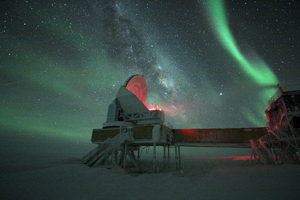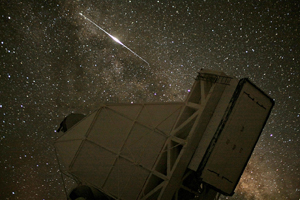Cosmologists seek to identify the physics of key components in their picture of the universe
By Steve Koppesskoppes@uchicago.edu
News Office
 Photo by Keith Vanderlinde The Aurora Australis (the Southern Lights) glow over the South Pole Telescope. |
|
 The dark sky over the South Pole Telescope shows the Milky Way, from the top left to the bottom right. The white streak is likely a satellite in this timed exposure. |
|
A new universe could pop into existence at just about any time, in any place, according to the theory of cosmic inflation—perhaps even in John Carlstrom’s office in the Laboratory of Astrophysics and Space Research.
Scientists have no way of detecting other universes, but scientists have devised a test that could verify another key feature of cosmic inflation: gravitational waves. Einstein’s theory of general relativity predicts that cosmic inflation should produce these extremely weak waves.
“If you detect gravitational waves, it tells you a whole lot about inflation for our universe,” said Carlstrom, the S. Chandrasekhar Distinguished Service Professor in Astronomy & Astrophysics and the College. It also would rule out various competing ideas for the origin of the universe. “There are fewer than there used to be, but they don’t predict that you have such an extreme, hot big bang, this quantum fluctuation, to start with,” he said. Nor would they produce gravitational waves at detectable levels.
Carlstrom and Chicago colleague Scott Dodelson were among the cosmologists who participated in a panel discussion about the origins and endings of the universe during the 2009 annual meeting of the American Association for the Advancement of Science in Chicago. They also met with a group of approximately 30 science journalists during a news briefing.
Fellow panelists included Alan Guth of the Massachusetts Institute of Technology. In 1979, Guth proposed the cosmic inflation theory, which proposes that a random, microscopic density fluctuation in the fabric of space and time gave birth to the universe in a hot big bang approximately 13.7 billion years ago.
Inflation theory predicts the existence of an infinite number of universes. Unfortunately, it is impossible for cosmologists to test this prediction.
“Since these are separate universes, by definition that means we can never have any contact with them. Nothing that happens there has any impact on us,” said Dodelson, Professor in Astronomy & Astrophysics at the University and a scientist at Fermi National Accelerator Laboratory.
But there is a way to probe the validity of cosmic inflation. The phenomenon would have produced two classes of perturbations. The first, fluctuations in the density of subatomic particles happen continuously throughout the universe, and scientists have already observed them.
“Usually they’re just taking place on the atomic scale. We never even notice them,” Dodelson said. But inflation would instantaneously stretch these perturbations into cosmic proportions. “That picture actually works. We can calculate what those perturbations should look like, and it turns out they are exactly right to produce the galaxies we see in the universe.”
The second class of perturbations would be gravitational waves—Einsteinian distortions in space and time. Gravitational waves also would get promoted to cosmic proportions, perhaps even strong enough for cosmologists to detect them with sensitive telescopes turned to the proper frequency of electromagnetic radiation.
“We should be able to see them if John’s instruments are sensitive enough,” Dodelson said.
Carlstrom and his associates are building a special instrument, a polarimeter, as an attachment to the South Pole Telescope to search for gravitational waves.
Carlstrom operates the SPT with a team of scientists from nine institutions in their search for evidence about the origins and evolution of the universe. The SPT operates at submillimeter wavelengths, between microwaves and the infrared on the electromagnetic spectrum.
Cosmologists also use the SPT in their quest to solve the mystery of dark energy. A repulsive force, dark energy pushes the universe apart and overwhelms gravity, the attractive force that all matter exerts. Dark energy is invisible, but astronomers are able to see its influence on clusters of galaxies that formed within the last few billion years.
The SPT detects the cosmic microwave background radiation, the afterglow of the big bang. Cosmologists have mined a fortune of data from the CMB, which represent the forceful drums and horns of the cosmic symphony. But now the scientific community has its ears cocked for the tones of a subtler instrument—gravitational waves—that underlay the CMB.
“We have these key components to our picture of the universe, but we really don’t know what physics produces any of them,” said Dodelson of inflation, dark energy and the equally mysterious dark matter. “The goal of the next decade is to identify the physics.”
![[Chronicle]](/images/sidebar_header_oct06.gif)